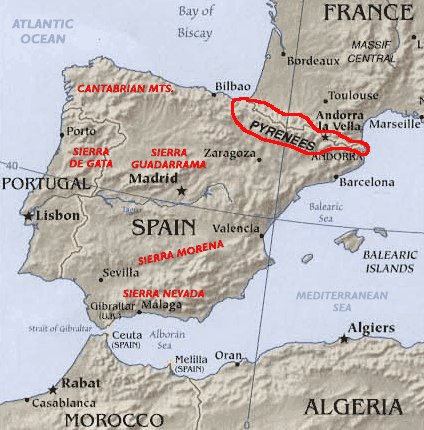Spain Trails
I walked across Spain twice. The 2,000-km (1,250-mile) hike took 50 days and was divided into two parts: the Pyrenees and El Camino Santiago.

The Pyrenees
This east-west mountain range divides Spain and France. I started at Cap de Creus, which juts out of Spain and is where Salvador Dali loved to paint.
From this cape, I walked northwest along the Mediterranean Sea until I reached Banyulys-sur-Mer, France. I wet my fingers in the Mediterranean Sea one last time before climbing up into the Pyrenees. I continued hiking 800 km until I got to Hendaye, a town in the Basque country. It was a nice adventure from the Mediterranean Sea to the Atlantic Ocean!
I followed the GR 11 and the HRP (High Route Pyrenees) and did some of GR 10. Snow fell on me in late September and early October in the Pyrenees, so I stepped on the gas and finished the hike in 25 days.
Although I said that I am walking across Spain, technically I was constantly hopping across the Spain-France border. As much as possible, I stood in Spain and peed in France.
Cap de Creus on Google Maps
El Camino Santiago
El Camino Santiago de Compostela is to Europeans what the Appalachian Trail (AT) is to Americans. In French, El Camino is called Le Chemin Saint Jacques (The Way of St. James). Although there are similarities between the AT and El Camino, there are six remarkable differences.

2. True pilgrims are supposed leave from their doorstep and walk to Santiago de Compostela. This is part of the reason there are so many paths. It also explains why it’s impossible to say how long El Camino really is. However, it’s a bit for Americans (and other nationalities) to leave from their doorstep and walk to Spain. Therefore, one of the most popular starting points is near the northern France-Spain border. Following the most popular path, El Camino Frances (French Trail), you’ll end up walking about 800 km (500 miles).
3. Given all the potential hiking paths, you might think that everyone would sing the “hike your own hike” mantra. However, in some ways the opposite is true. To be considered a true “pilgrim”, you must get a special document that is stamped at various checkpoints along the trail. If you don't have it, you may not be admitted to the many huts along the way. Some may question the legitimacy of your pilgrimage if you don't have enough stamps at the finish line.
4. There's even a pilgrim look. You're encouraged to carry a seashell and a walking stick (trekking poles are acceptable). Although you bike most of the trail, pilgrims view bikers as second class citizens.
5. Unlike the AT, El Camino is a religious pilgrimage. However, Europeans are less religious than Americans, so in practice most people do it for secular or “spiritual” reasons.
6. The Way of St. James is the Ritz Carlton of long distance trails. Every 10-20 km there is a hut, which make the three walled AT shelters look pathetic. It costs only about $5 to stay in a hut. They serve food and have showers available. That's right folks, on the Way of St. James it's possible to have a shower nearly every day! That's a far different than the CDT, where I went 45 days without a shower.
Despite all the amenities, I'm going to be a boring, old-fashioned thru-hiker, carrying most of my food and avoiding huts filled with snoring hikers.
Satellite photos reveal that El Camino is being geologically dull compared to the Pyrenees, PCT, and CDT. Instead of alpine mountains, El Camino is closer to AT, with mostly rolling hills near (or through) farmlands. I bought an MP3 player, loaded it up with podcasts and audio books from Librivox to help me fight potential boredom.
On the other hand, it will be fun to be on a social trail again. Like the AT, the Way of St. James is filled with section hikers and thru-hikers. A myriad of languages are spoken on El Camino as people descend into Spain from a variety of European countries. Luckily I'm fluent in French and Spanish, so I should be able to chat with most hikers. I'll drape myself in an American flag to blend in.
I plan to hike the 800 km of El Camino in three weeks, which is about the same time I expect to do the 800 km in the Pyrenees. At first, this seems odd because the Pyrenees terrain is much harder than El Camino. You might conclude that I would take I should take less time to do 800 km on El Camino than to do 800 km in the Pyrenees. However, there will be three things slowing me down on El Camino:
1. Light: Spain is loses light fast in October. I’ll be doing the Pyrenees with about 11 hours of light. I’ll be finishing the Camino with just over 9 hours of light. Although I will do night hiking, it’s never as efficient as day hiking.
2. Temperature. It will be freezing every night in the Pyrenees, which scrape 3,000 meters (10,000 feet). This will encourage me to hike long hours to escape the cold. Once I descend to El Camino, temps will rise since the average elevation on El Camino is only 500 meters (about 1,700 feet). Knowing that I won’t have to deal with snow on El Camino during October will encourage me to slow down.
3. Social distractions. I suspect the best thing about El Camino won’t be the scenery, but rather meeting the hikers. Although I’m not sure how much I will camp and hike with other hikers, I’m sure I will and that will slow me down. But I’m not complaining, just explaining.
Reaching the end of Europe
My first book had about 85,000 words (352 pages). I’ve already written over 200,000 words for my second book! Yes, that means unless I do some serious editing and/or use a small font, it’s going to be a thick book!
Do you have a question about backpacking through Spain? I encourage you to post any question on my forum.
I mentioned that in some ways El Camino discourages you to hike your own hike. However, the fact that there are many hiking paths and that bikers are usually allowed, shows that it is truly an “anything-goes” trail. I encourage you to also hike your own hike in everyday life. Please learn what that means by reading my first book, Hike Your Own Hike.
- What nobody tells you about the Camino Portuguese with Santiago Ways
- 8 Videos on Where To Go and What To See In Andalucía
- Hiking Caminito del Rey Entrance & Bridge
- Step Off The Tourist Trail in Lanzarote
- A First-Timer’s Guide to Hiking in Tenerife
- Pamplona: is there life beyond the bulls?
- Skydiving over Empuriabrava
- 10 Reasons Why El Camino Santiago Sucks
- Los Picos de Europa and Asturias
- El Camino Santiago or the Way of St James
- High Pyrenees to the Atlantic Ocean
- Mediterranean to Andorra via the Pyrenees
Your comment will be deleted if:
- It doesn't add value. (So don't just say, "Nice post!")
- You use a fake name, like "Cheap Hotels."
- You embed a self-serving link in your comment.




